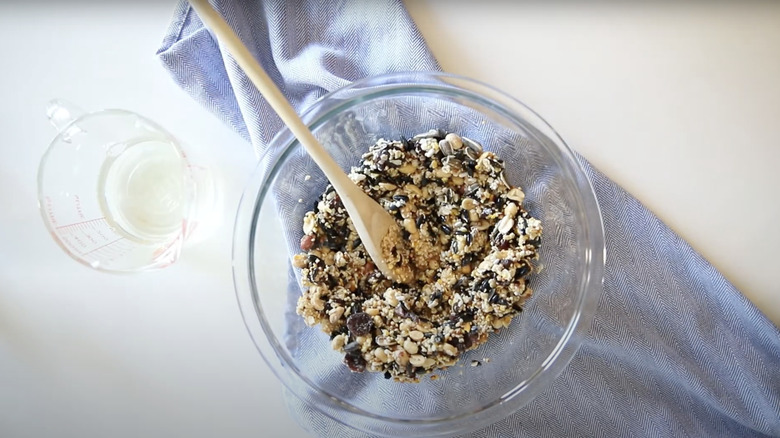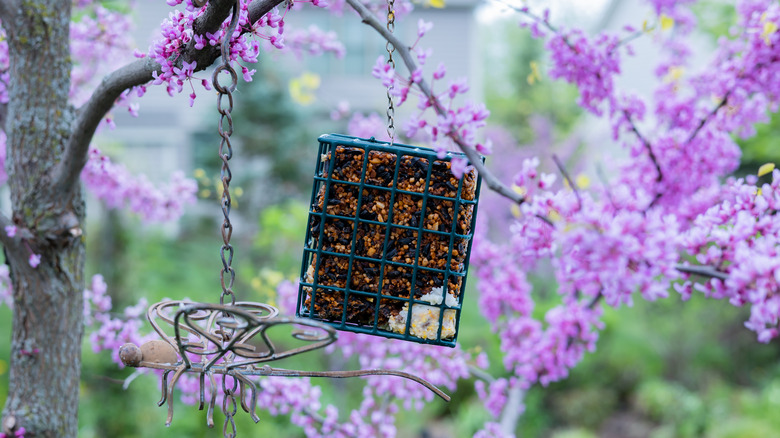Don't Overlook These Common Mistakes When Making DIY Bird Suet
We may receive a commission on purchases made from links.
Watching birds flint from trees to feeders just outside your window is one of life's most pleasurable experiences. But the pastime can be expensive, with seed and suet prices soaring due to a combination of droughts, rising fuel costs to transport it to stores, and of course, inflation. This may have you wondering if you can DIY your own suet blocks to feed your outdoor feathered friends. You absolutely can. The process, while messy, can be very satisfying. But according to Chad Witko, Senior Coordinator of Avian Biology with the National Audubon Society, using low quality seed, incorporating unsafe ingredients that melt in warm weather, and hanging feeders in dangerous spots are common mistakes you shouldn't overlook when making DIY bird suet.
"When properly prepared and maintained, suet is an excellent way to attract and support birds during the colder months, providing opportunities for birdwatching and photography in your outdoor space," Witko told House Digest during his exclusive interview. "However, like seeds or nectar, suet should be viewed as a complement to native plants, which provide not only food but also shelter, protection, and places to roost, nest, and raise young." If you're thinking about making DIY suet, you may want to head to your local nursery first because native plants are perfect for bringing birds to your yard. To find the right species for your area, try the Audubon Native Plants Database. According to Witko, the organization also "offers a wide range of seed, feed, and suet that can support birds and attract a variety of species."
Avoid low-quality ingredients that can't stand up to warmer temperatures
Most DIY suet recipes involve mixing bird seed with melted lard or rendered fat, with the option of adding treats like dried fruit or nuts before forming it into squares or logs. In his exclusive interview with House Digest, Chad Witko said it's important to pick your ingredients based on the time of year and anticipated temperatures. "Timing is important. Suet is best during colder months when birds need extra energy to stay warm," he explained. "Some DIY recipes are not recommended for outdoor temperatures above 50 degrees because ingredients can turn rancid or melt where dripping fat can damage the natural waterproofing on bird feathers or cause smaller birds to get stuck."
Another common mistake people frequently make when mixing up DIY bird suet is using the wrong ingredients. "Use a variety of high-quality seeds to attract different bird species," Witko recommended. "Black oil sunflower seed is the best overall choice for the greatest variety of birds or add Nyjer, sometimes called thistle, for finches." At just $0.10 per ounce, the 25 Pound Bag of Wagner's Black Oil Sunflower Wild Bird Food is a cost effective option with thousands of five star reviews. If you aren't going to use all of it right away for making a large quantity of DIY suet, remember to store your bird seed in an airtight container located in a cool, dry place. Along with keeping it fresher for longer, this also prevents unwanted critters from ruining your seed.
Keep your bird feeders well maintained and near native plants
Once you've made your suet blocks, Chad Witko has some safety tips. "Minimize the risk of window collisions by placing bird feeders less than 3 feet or more than 10 feet from your home, and by turning off excess lighting during spring and fall migration," he told House Digest during his exclusive interview. Along with hanging your bird feeders in the right spot, the ornithologist recommends spending a little extra time setting them up. "Minimize squirrels or rodents becoming an issue by placing your suet feeder atop a squirrel-proof pole with a baffle or hanging off another feeder atop this setup," he recommended. Available in several colors and two different sizes, the Predator Guard Squirrel Baffle is a highly-rated option you may want to consider.
Witko also said you should clean your bird feeders frequently. "Regular cleaning is crucial to maintaining a healthy environment for birds. Suet feeders should be washed with each re-fill using soap and water," he explained. Neglecting to regularly clean your suet feeders can lead to mold growth.
According to Witko, there are two other things you should keep in mind if you plan to feed backyard birds. "Growing native plants will provide vital habitat for birds and pollinators and help them adapt and survive in the face of climate change," he said. Witko also warned that although the risk of avian flu transmission to bird watchers is low, you should follow guidance on birdfeeder safety.


